It is a forgotten story now, but on 14 November 1889, two young women began racing each other around the world in an odyssey that captured newspaper readers everywhere. Their goal was to beat Jules Verne’s fictional record set by his hero in the 1873 novel Around the World in Eighty Days.
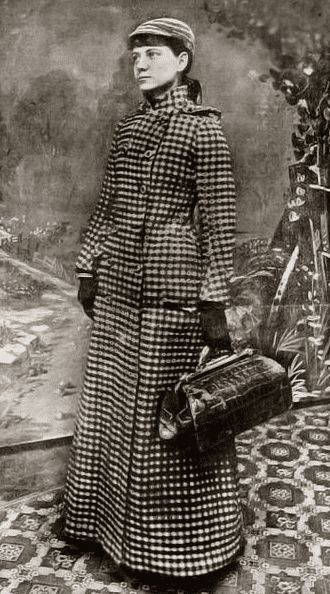
The idea began with investigative reporter Nellie Bly, who worked for Joseph Pulitzer’s New York World newspaper. The daring 25-year-old had already made a name for herself with exposes of an abusive mental hospital, the squalid conditions in sweatshops, and the cruelty of the illegal trade in newborn babies. Now she was ready for a grand adventure, and her shrewd publisher, needing a boost in circulation, readily agreed.
Hearing this, John Brisben Walker, who published Cosmopolitan magazine, decided to send his literary editor, 28-year-old Elizabeth Bisland, in a race against Bly by traveling in the opposite direction. They both left from New York, Bly heading east, Bisland west.
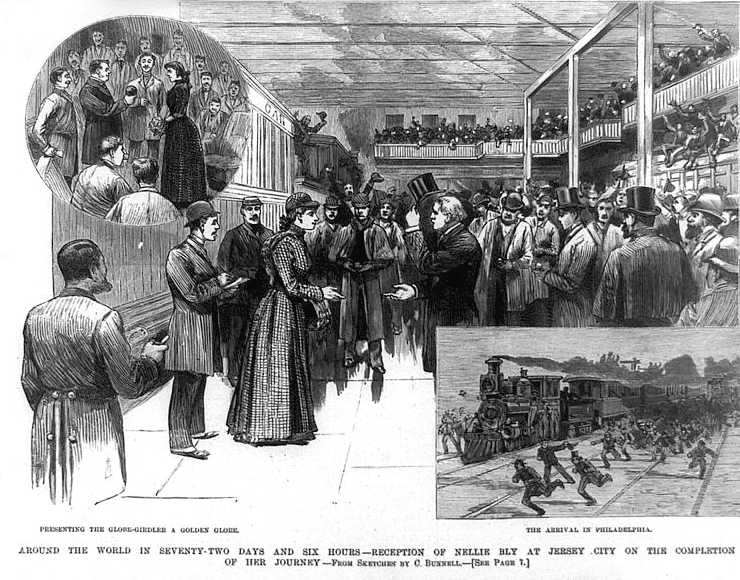
Bly won the race by circumnavigating the globe in 72 days. Her adventure included a celebrated visit in France with Jules Verne himself, and she triumphantly arrived back in New York on 25 January 1890, greeted by large crowds.
By contrast, Bisland arrived four days later with almost no one to greet her, and none of her rival’s fame.
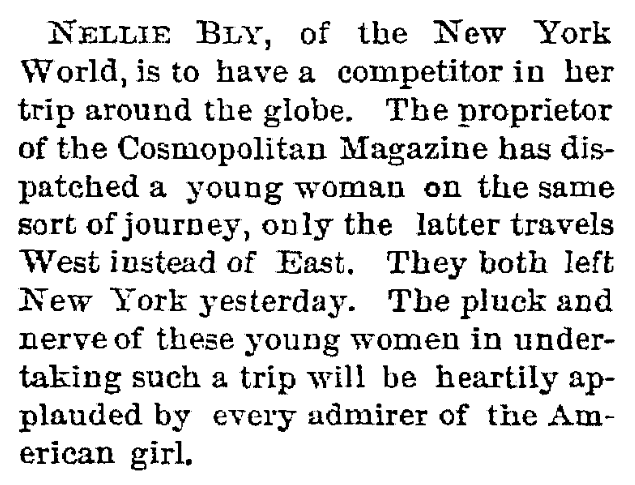
Here is a transcription of this article:
NELLIE BLY, of the New York World, is to have a competitor in her trip around the globe. The proprietor of the Cosmopolitan magazine has dispatched a young woman on the same sort of journey, only the latter travels West instead of East. They both left New York yesterday. The pluck and nerve of these young women in undertaking such a trip will be heartily applauded by every admirer of the American girl.
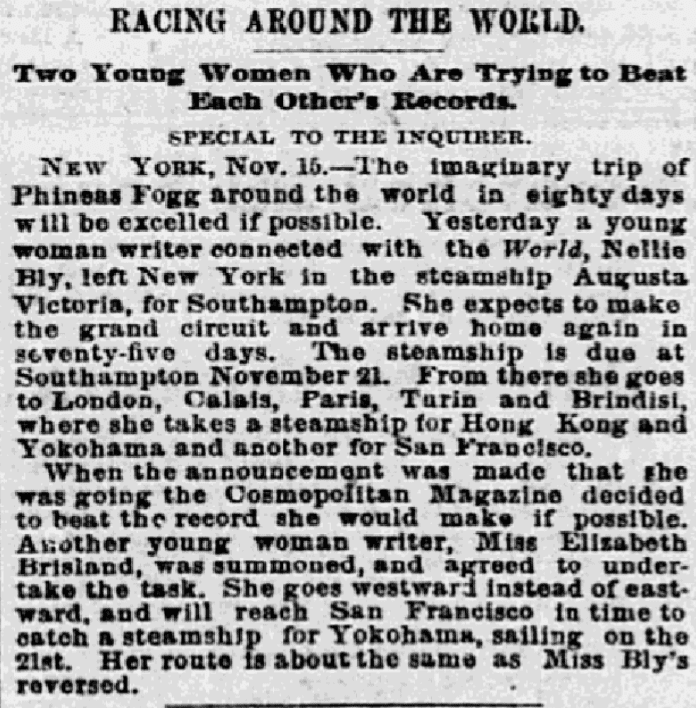
Here is a transcription of this article:
RACING AROUND THE WORLD.
Two Young Women Who Are Trying to Beat Each Other’s Records.
Special to the Inquirer.
NEW YORK, Nov. 15. – The imaginary trip of Phineas Fogg around the world in eighty days will be excelled if possible. Yesterday a young woman writer connected with the World, Nellie Bly, left New York in the steamship Augusta Victoria, for Southampton. She expects to make the grand circuit and arrive home again in seventy-five days. The steamship is due at Southampton November 21. From there she goes to London, Calais, Paris, Turin and Brindisi, where she takes a steamship for Hong Kong and Yokohama and another for San Francisco.
When the announcement was made that she was going the Cosmopolitan Magazine decided to beat the record she would make if possible. Another young woman writer, Miss Elizabeth Bisland, was summoned, and agreed to undertake the task. She goes westward instead of eastward, and will reach San Francisco in time to catch a steamship for Yokohama, sailing on the 21st. Her route is about the same as Miss Bly’s reversed.
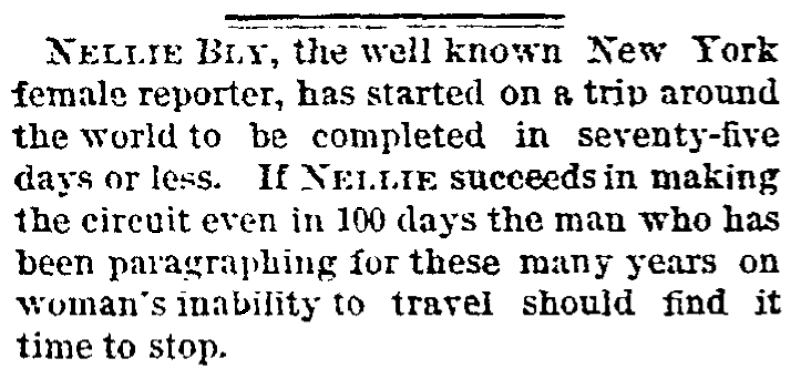
Here is a transcription of this article:
NELLIE BLY, the well-known New York female reporter, has started on a trip around the world to be completed in seventy-five days or less. If NELLIE succeeds in making the circuit even in 100 days the man who has been paragraphing for these many years on woman’s inability to travel should find it time to stop.
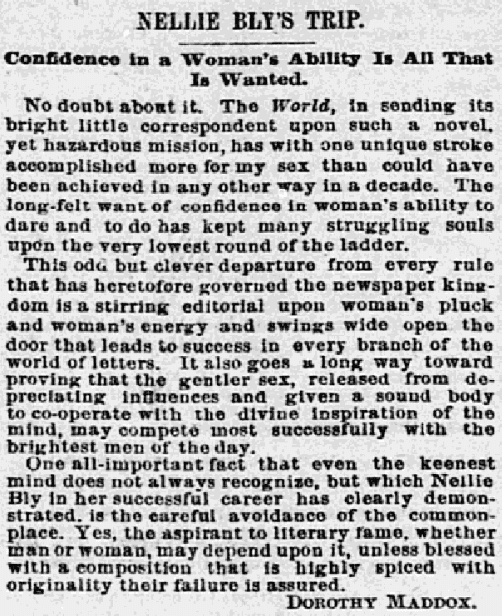
Here is a transcription of this article, a “letter to the editor”:
NELLIE BLY’S TRIP.
Confidence in a Woman’s Ability Is All That Is Wanted.
No doubt about it. The World, in sending its bright little correspondent upon such a novel, yet hazardous mission, has with one unique stroke accomplished more for my sex than could have been achieved in any other way in a decade. The long-felt want of confidence in woman’s ability to dare and to do has kept many struggling souls upon the very lowest round of the ladder.
This odd but clever departure from every rule that has heretofore governed the newspaper kingdom is a stirring editorial upon woman’s pluck and woman’s energy and swings wide open the door that leads to success in every branch of the world of letters. It also goes a long way toward proving that the gentler sex, released from depreciating influences and given a sound body to cooperate with the divine inspiration of the mind, may compete most successfully with the brightest men of the day.
One all-important fact that even the keenest mind does not always recognize, but which Nellie Bly in her successful career has clearly demonstrated, is the careful avoidance of the commonplace. Yes, the aspirant to literary fame, whether man or woman, may depend upon it: unless blessed with a composition that is highly spiced with originality, their failure is assured.
–Dorothy Maddox
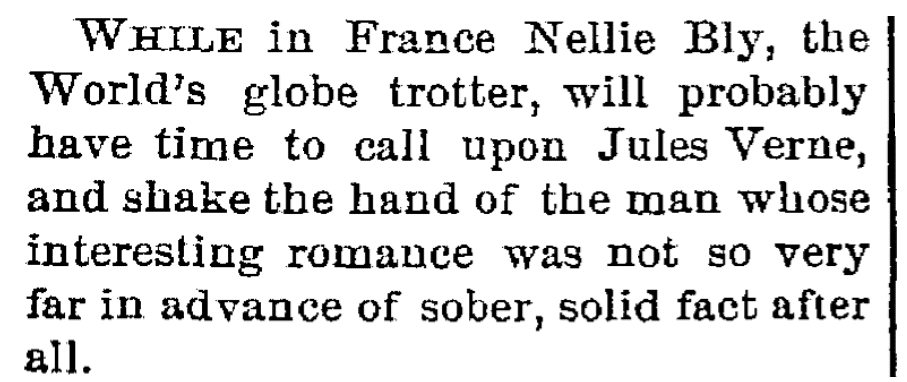
Here is a transcription of this article:
WHILE in France Nellie Bly, the World’s globe trotter, will probably have time to call upon Jules Verne, and shake the hand of the man whose interesting romance was not so very far in advance of sober, solid fact after all.
Note: That visit did happen, as the delighted French novelist and his wife met Bly at the Amiens train station in northern France and brought her to their house for a visit.
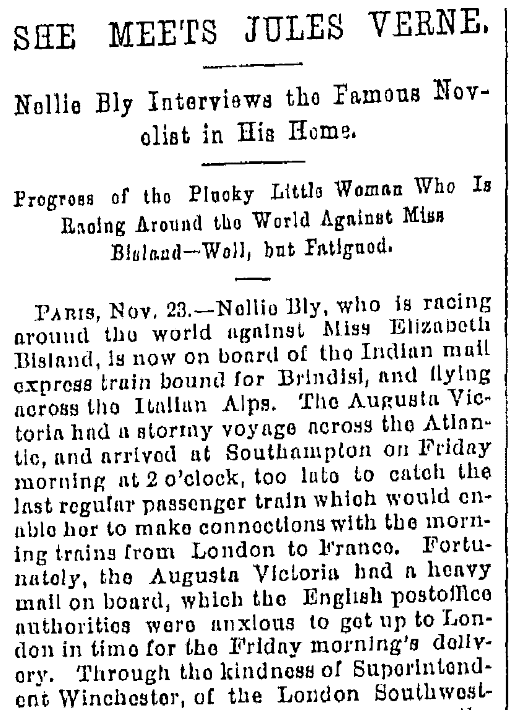
Here is a transcription of this article:
SHE MEETS JULES VERNE.
Nellie Bly Interviews the Famous Novelist in His Home.
Progress of the Plucky Little Woman Who Is Racing around the World against Miss Bisland—Well, but Fatigued.
PARIS, Nov. 23. – Nellie Bly, who is racing around the world against Miss Elizabeth Bisland, is now on board of the Indian mail express train bound for Brindisi, and flying across the Italian Alps.
…She just had time to get a hurried breakfast at the Charing Cross hotel, and then boarded the tidal train via Folkestone and Bologne for Amiens, where she was to meet Jules Verne, the famous novelist and author of “Round the World in Eighty Days.”
At 4 o’clock yesterday afternoon M. and Mme. Verne were pacing up and down the platform of the Amiens railway station. The excitement of the old gentleman knew no bounds, and every now and again he exclaimed:
“When is she coming? Mon Dieu, I hope nothing has happened. I feel as much interested in the success of this enterprise as I did when I was following Phineas Fogg and his friends round the world in my study.”
Verne Greets Her.
Luckily, nothing had happened, only the train from Bologne was a few minutes late. Presently it came steaming into the Amiens station, and Jules Verne and his wife stepped hastily forward. Miss Bly alighted and the next minute was smilingly shaking hands with the gray-haired novelist and Mme. Verne. The latter was delighted with Miss Bly’s appearance, and kept on repeating: “Mon Dieu, what a child. Is it possible that lady is going all that long way alone?”
Owing to Miss Bly’s limited acquaintance with the French language and Mme. Verne’s ignorance of English the conversation between the two ladies was somewhat restricted. But Miss Bly was able to place a few random “ouis” in a singularly happy manner, and seemed to get along capitally.
In about twenty minutes the Verne residence was reached.
Plucky Little Woman.
“The first thing I want to know,” exclaimed Mr. Verne, “is what route you are going to follow.”
“The New York, Southampton, Calais, Brindisi, Colombo, Hong Kong, Yokohama, San Francisco, New York route,” replied Nellie Bly, delighted at being able to speak an entire French sentence without a mistake.
Talking about the Trip.
“Why do you not land at Bombay and travel across India to Calcutta like Phineas Fogg?”
“No, it would not be any use,” replied Nellie Bly. “You see I would have to wait a day or two longer in Yokohama, and there would be no advantage in that. Besides, you know, people who cross India in these expeditions,” referring to one of the incidents in Jules Verne’s novel, “come back married, and that is just what I do not want to do.”
The Vernes laughed heartily at this, and then the author said: “It really is not to be believed that that little girl is going all alone around the world; why, she looks a mere child.”
“Yes, but she is just built for work of that sort,” remarked Madame Verne, who seemed to have taken quite a fancy to the girl. “She is trim, energetic and strong. I believe, Jules, that she will make your heroes look foolish; she will beat your record.”
Jules Verne shook his head, and replied, laughing: “I would not like to risk my money.”
Visiting the Study.
While Jules Verne was speaking, Nellie Bly had her watchful eye on a Louis Quinze clock that hung opposite, and she saw that time was ebbing fast away.
“Would you let me see your room?” she asked; “the room in which you write your books.”
“Oh, with the greatest pleasure,” replied M. Verne, and, taking up a lamp, he led the way through the hall into the turret staircase, at the top of three flights of which are situated his private apartments. His room, which serves as a study and bedroom in one, is in a corner of the house, with windows on two views over the city. Against the wall is a simple camp bedstead, and against the window a small table, on which were most tidily arranged his books, writing materials and paper. It happened that just then there was on the table the manuscript of his last novel, “Sans Dessus Dessous,” which treats about Americans who, for the sake of speculation, make an attempt to change the axis of the earth so as to convert polar regions into a fertile garden.
Miss Nellie Bly was impatient to get back to the railway station, and when the time for starting came Mme. Verne insisted on kissing Miss Nellie, and did it right affectionately, while her kind husband shook hands many times and repeated: “Good luck, Nellie; good return.”
Note: An online collection of newspapers, such as GenealogyBank’s Historical Newspaper Archives, is not only a great way to learn about the lives of your ancestors – the old newspaper articles also help you understand American history and the times your ancestors lived in, and the news they talked about and read in their local papers.
Related Article:
